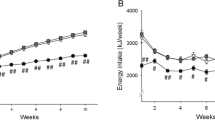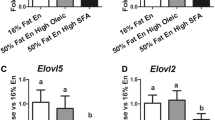Summary
Background
Conjugated linoleic acids (CLAs) exert numerous effects in animal models as well as in humans. Among other things, CLAs decrease plasma lipid levels and bring about hepatic steatosis. The latter effects are attributed to an agonistic action of CLAs on the peroxisome-proliferator-activated receptor family primarily responsible for activating genes involved in lipid metabolism and are related to changes in mRNA levels. Such changes are not necessarily reflected in changes in activity of controlling enzymes.
Aim of the study
To investigate the effects of CLAs treatment on lipid metabolism, we determined lipid concentrations in plasma, lipoproteins and liver and measured the activity of a number of key enzymes in hepatic lipid metabolism as differences in lipid concentrations should be related to changes in enzyme activities. These variables were determined with the rat as a model.
Methods
Rats were fed a control diet or a diet containing 1.15% trans-10, cis-12 isomer and 1.11% cis-9, trans-11 isomer as part of a commercial mixture of CLAs. After 2 w the animals were killed, and plasma and liver fractions isolated. Subsequently, lipid concentrations of cholesterol, triacylglycerols and phospholipids were determined in the isolated lipoproteins. In livers homogenates, the concentrations of glycogen, cholesterol, triacylglycerol and phospholipids and the activities of enzymes catalyzing pacesetting steps of metabolism were determined, i. e. acetyl-CoA carboxylase, fatty acid synthase, diacylglycerol acyltransferase, 3-hydroxy- acyl-CoA dehydrogenase, citrate synthase and phosphofructokinase.
Results
CLAs induced a lowering of the cholesterol levels in total plasma and in LDL and HDL lipoproteins and of phospholipid concentrations in LDL and HDL. CLAs treatment decreased the hepatic activity of diacylglycerol acyltransferase and had no effect on any of the other enzyme activities.
Conclusions
In other studies enhanced specific activities of ACC and FAS were found in livers of mice using the same or similar methods and experimental protocol as in the present study. The lack of effect of CLAs treatment on hepatic key enzymes of fatty acid synthesis and oxidation in Wistar rats questions the use of this strain for studying the mechanism(s) underlying CLA’s effects on these parameters. However, in the rat model we observed reduced levels of cholesterol in total plasma and in LDL and HDL. Therefore, some aspects like loss of body fat are better studied in mice; for other aspects like reduction in serum cholesterol level the rat may be the model of choice.
Similar content being viewed by others
Abbreviations
- ACC:
-
acetyl-CoA carboxylase
- CS:
-
citrate synthase
- CPT-I:
-
carnitine palmitoyltransferase-I
- CLAs:
-
conjugated linoleic acids
- DGAT:
-
diacylglycerol acyltransferase
- FAS:
-
fatty acid synthase
- 3-HAD:
-
3-hydroxy-acyl-CoA dehydrogenase
- PPAR:
-
peroxisome-proliferator-activated-receptor
- TAG:
-
triacylglycerols
- TCC:
-
tricarboxylate carrier
Author information
Authors and Affiliations
Corresponding author
Additional information
1 Supported in part by the Stichting Toxicologisch Onderzoek Utrecht and by the Netherlands Foundation of Chemical Research (SON) with financial aid from the Netherlands Organization for Scientific Research (NWO).
Rights and permissions
About this article
Cite this article
Giudetti, A.M., Beynen, A.C., Lemmens, A.G. et al. Hepatic lipid and carbohydrate metabolism in rats fed a commercial mixture of conjugated linoleic acids (Clarinol G-80TM)1 . Eur J Nutr 44, 33–39 (2005). https://doi.org/10.1007/s00394-004-0489-8
Received:
Accepted:
Published:
Issue Date:
DOI: https://doi.org/10.1007/s00394-004-0489-8




